The
Highway Capacity Manual made a leap forward with the 2010 Edition including multi-modal level of service. Unfortunately, I don't think it's being widely implemented. No one seems interested in paying us to use it in Minnesota even though agencies are progressive with our multi-modal systems. Charlotte, North Carolina created a bicycle and pedestrian level of service (LOS) tool as part of their Urban Street Design Guidelines. The bicycle and pedestrian LOS was designed to help evaluate intersections from a multimodal perspective taking into account those who choose to walk, bike or take mass transit to get to their destination. Madeline Brozen, assistant director of the University of California Los Angeles Institute of Transportation Studies, in the April 2015 ITE Journal titled
"Moving Ahead for Multimodal Performance Measures" (page 36) about applying Charlotte, North Carolina's bicycle and pedestrian level of service tool. Brozen's team applied the tool to intersections in Santa Monica, California to determine if it would be useful/relevant outside of Charlotte. Her conclusion was that it is relevant, but she didn't really supply any metrics to prove it's applicability. Still, I think the Charlotte methodology detailed in the article is valid and should be used by cities to test their intersections for potential multi-modal improvements. The figures on the side show the rankings of the five intersections Brozen tested compared to the maximum possible score.

The process is straightforward and the input data can largely be collected from Google Earth. An important caveat - the criteria and their weighting system should be tweaked to incorporate the things your community values. Criteria for transit stops could be added too. This evaluation system could be easily built by an intern and then used to flag problem intersections. Senior staff would then dig into the factors contributing to each "sub-standard" intersection to see what improvements could be made. Things like changing signal timing or using planters to create bumpouts (like we did in Pine Island) are low cost improvements that could be rolled out quickly.

 The process is straightforward and the input data can largely be collected from Google Earth. An important caveat - the criteria and their weighting system should be tweaked to incorporate the things your community values. Criteria for transit stops could be added too. This evaluation system could be easily built by an intern and then used to flag problem intersections. Senior staff would then dig into the factors contributing to each "sub-standard" intersection to see what improvements could be made. Things like changing signal timing or using planters to create bumpouts (like we did in Pine Island) are low cost improvements that could be rolled out quickly.
The process is straightforward and the input data can largely be collected from Google Earth. An important caveat - the criteria and their weighting system should be tweaked to incorporate the things your community values. Criteria for transit stops could be added too. This evaluation system could be easily built by an intern and then used to flag problem intersections. Senior staff would then dig into the factors contributing to each "sub-standard" intersection to see what improvements could be made. Things like changing signal timing or using planters to create bumpouts (like we did in Pine Island) are low cost improvements that could be rolled out quickly.